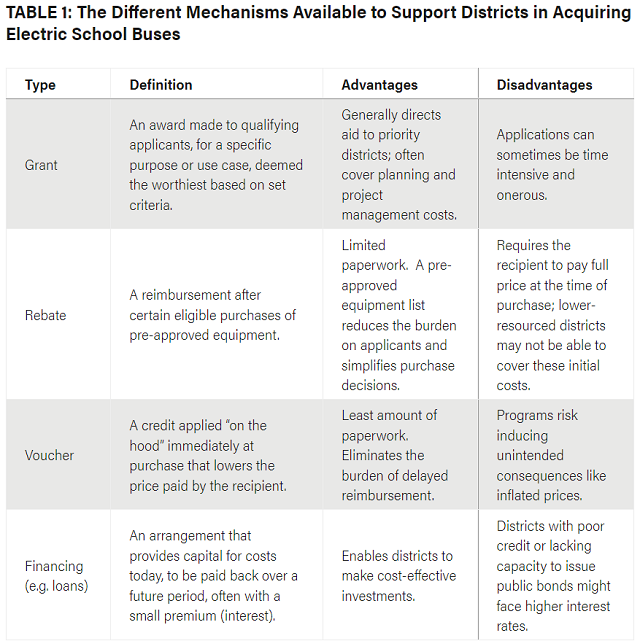
The benefits of electric school buses are clear, and communities across the United States are eager to get on board. What’s more, many of the advantages of electric school buses are even more consequential for low-income and underserved school communities, as discussed in a previous article in this series.
However, there is a long road to travel before electric school buses are the norm across the country. As of August 2021, fewer than 1% of school buses are electric. Just over 1,000 electric school buses, out of a total fleet of more than 480,000, have been committed — meaning announced, procured, delivered or in operation.
For many districts eager to get electric school buses on the road, one of the main barriers is the upfront price premium of the buses, which can cost as much as three times that of a diesel bus. In addition to the cost of the electric buses themselves, districts may need to account for the cost of purchasing and installing charging equipment, including any necessary facility upgrades.
Momentum towards electric school bus adoption is building, spurring a growing range of funding and financing opportunities from the federal and state governments, electric utilities and local agencies to help communities overcome these initial economic barriers. These funding opportunities can be complex to navigate. Here’s how school districts can help secure funding to bring electric school buses to their community.
Breaking it Down: How to Access Financial Support
There are many types of funding mechanisms that have been used to deliver financial support to districts for electric school buses, illustrated in Table 1, with different advantages and disadvantages.

Here we explain a variety of sources for funding from federal, state and local governments and utilities as well as tips on potential financing approaches:
1. Federal Funding
Significant opportunities for federal funding to support school bus electrification are rolling out this year. The Infrastructure and Investment Jobs Act (IIJA) that was signed into law in November 2021 included $2.5 Billion dedicated exclusively for electric school bus procurements, and another $2.5 Billion dedicated for clean school buses for which electric buses will be eligible, alongside alternative fuel buses. The Environmental Protection Agency (EPA), which will administer the Clean School Bus Program, is still ironing out details for the program’s design, but is allowed to prioritize support for schools serving low-income and historically marginalized communities, and most likely will do so in alignment with the administration’s Justice40 Initiative.
The EPA is also expected to provide funding for administrative costs and workforce training. Guidance on this new program, which is funded for at least five years, is expected mid-March and will provide more details on the level and types of support for various eligible recipients. This site is the one to check for updates.
While the new federal funding represents an important investment that will help catalyze the market, advance greater scale and drive down costs in the future, the amount is enough to support the turnover of only a fraction of the fleet of some 480,000 school buses. Many school districts will need to find other sources of support to realize their electric school bus plans.
Luckily, there are additional sources of federal funding that can help with vehicle or infrastructure costs. Many schools have made use of EPA funding for school buses through Diesel Emission Reduction Act rebates. Past awards of up to $65,000 can be enough to cover the cost of some diesel-to-electric repower retrofits or reduce the lifetime cost premium of an ESB by more than 50%. Other districts, such as Knox County R-I School District in Missouri, have made use of U.S. Department of Agriculture Rural Development’s Community Facilities loan & grant program to fund electric school buses for their communities.
There are also new funding programs under the IIJA that could support electric school buses, including:
- $3 billion for the Smart Grid Investment Grant Program that funds customer systems like energy storage devices and EVs that enable smart grid functions;
- $7.5 billion for a national EV charging network, which could supplement charging infrastructure sited at bus yards and depots; and,
- $500 million for the State Energy Program, which states can leverage to administer funding programs like the state of Maryland’s Solar Canopy with EV Chargers Grant Program.
More potential opportunities under the IIJA, are in K-12 Climate Action’s summary resource.
2. State Funding
States are also an important source of funding for school bus electrification. California began providing funds for school districts through its California Hybrid and Zero-Emission Truck and Bus Voucher Incentive Project (HVIP) in 2018 and has since awarded over $116 million for electric school buses through the program. New York State’s Truck Voucher Incentive Program and Massachusetts’ Vehicle-to-Grid Electric School Bus Pilot Program are other early examples of states providing funding for electric school buses. The state funding landscape has evolved due to the Volkswagen settlement funds, as discussed previously. However, many of these programs are oversubscribed and funding has run out, as has happened in Texas and in Ohio.
Thankfully, due to the popularity of these funding opportunities and the clear health and climate benefits they provide, many state agencies, legislatures and executives are redoubling their commitment to electric school buses and looking to establish new funding streams. These include a proposal from Colorado’s governor for an investment of $150 million in electric school buses in the state budget for fiscal years 2022-23 and a commitment by the governor of New York to expand the state’s Clean Green Schools Program through bond act funding. Additionally, the governor of California proposed a one-time allocation of $1.5 billion from the general fund to green school bus fleets and California Air Resources announced plans for a $130 million set-aside for public school buses for its 2022 HVIP awards. There are also state-funded programs for which school buses are eligible, although not explicitly targeted.
3. Local Agency and Utility Funding
Increasingly, local agencies and electric utility companies are also stepping in to help communities pursue the electrification projects they envision — and may offer additional funds besides state and federal support. Some examples of the entities that can be sources for funding include:
- Electric utility companies and their counterparts, municipal cooperatives and community choice aggregators, are central partners in all electrification projects and can also be a source of funds for bus electrification. Some utilities help school districts cover costs required to make a site ready for electric school buses, such as through Arizona Public Service’s Take Charge AZ Pilot, which provides chargers and electrical infrastructure at no cost to fleets. Others, like Duke Energy North Carolina’s EV School Bus program, provide additional funds as well as the charging infrastructure. Rural cooperatives can look to the example of Associated Electric Cooperated Incorporated and local affiliate Lewis County REC, which have provided funds for school bus electrification with the dual purposes of exploring bus performance and developing local talent.
- Air quality management districts offer programs to improve local air quality. Because electrification of fleet vehicles is an effective way to reduce air pollution, it is more and more common for these local agencies to dedicate funds for this purpose. For example, the Regional Air Quality Council that serves the Denver Metro Area/Northern Front Range offers the Charge Ahead Colorado program, which covers the costs of EVs and charging infrastructure. Funding opportunities can cover expenses beyond the capital costs of vehicles and charging infrastructure in some instances, such as the San Joaquin Valley Air Pollution Control District’s Alternative Fuel Mechanic Training program that provides up to $15,000 per fiscal year for training and education on the mechanics, safe operation and maintenance of alternative fuel vehicles and infrastructure.
- Metropolitan planning organizations have long supported coordination among member governments and agencies for better and more efficient provision of services. As EVs become a more central aspect of transportation systems, these regional planning entities are finding ways to support their adoption. One way is through coordination of group purchasing, also known as collective procurement, which can lower upfront prices and spread the administrative burden of contracting across more entities to lighten the load. A recently launched effort from Montgomery County, Maryland for light-duty vehicles is an example of this.
Financing Can Also Be an Important Tool for Addressing Upfront Costs
To date, most electric school buses have been procured through direct public aid, but where these funds do not cover the full incremental cost of an electric school bus, financing can be a crucial tool. Even after electric school buses reach total cost of ownership parity with diesel versions in future years, low-cost financing and alternative business models are likely to play a role in enabling districts to accommodate the higher capital requirements of an electric bus fleet compared to one comprised of their diesel predecessors.
Financing solutions enable school districts to monetize future maintenance and fuel savings and apply these towards the initial capital investments that electric buses require. Financing allows districts to restructure school bus electrification costs so that they more closely resemble the budget and cash flow characteristics of incumbent diesel vehicles and can enable districts to make the investments necessary to realize cost-effective projects.
Private lenders (like commercial banks) or public lending institutions (like state clean energy funds and green banks) provide upfront capital to borrowers that then pay back this amount, generally with interest, over the term of the agreement. Other private lenders are also active in the financing space, such as the financial institutions associated with vehicle manufacturers that facilitate leasing and tax-exempt financing, as well as transportation and infrastructure services companies such as Highland Electric Fleets , Levo Mobility, eTransEnergy and Amply Power, where financing is embedded in subscription fees. Another potential source for financing could be the local electric utility through a tariffed on-bill program, where the utility recoups its upfront capital investment via a surcharge on the customer’s bill.
School districts and local municipalities may also have direct access to capital markets through their bonding authorities and can issue bonds to cover electric school bus costs. Some districts are unaccustomed to employing financing in the context of their transportation needs; other districts may have poor credit or lack capacity to issue public bonds to raise capital and so might face higher interest rates that would result in higher overall project costs. In such instances public or private lending institutions could be key partners.
School districts looking to electrify are likely to find they can combine, or stack, multiple funding streams, as was done by Stockton Unified School District. After applying any of a number of these approaches, electric school buses offer benefits both for children and for a district’s balance sheet.
To connect with WRI’s Electric School Bus Initiative and learn more about bringing electric school buses to your community please fill out this form.
This is the second article in a three-part series examining the ways in which stakeholders — including state policymakers, school districts, and electric utilities — can build upon recent federal actions to accelerate the equitable transition to electric school buses across the U.S.
This article originally appeared on WRI’s Insights.
Michelle Levinson is Manager of eMobility Financial Solutions for the Electric School Bus Initiative at World Resources Institute.






